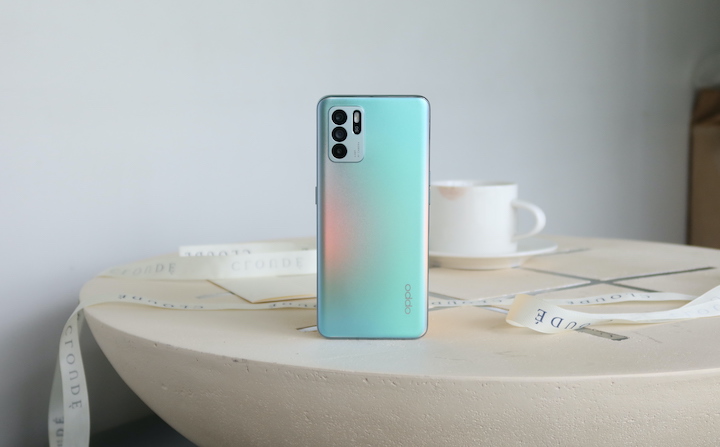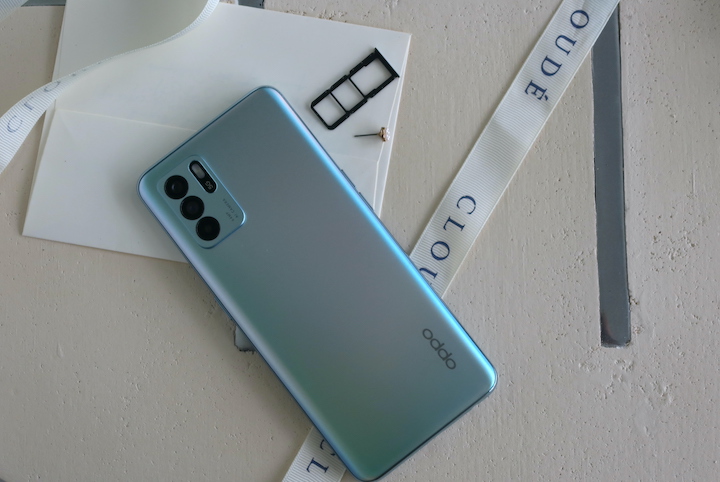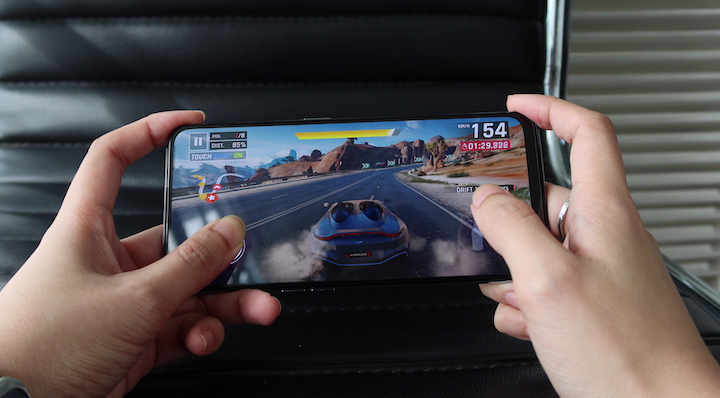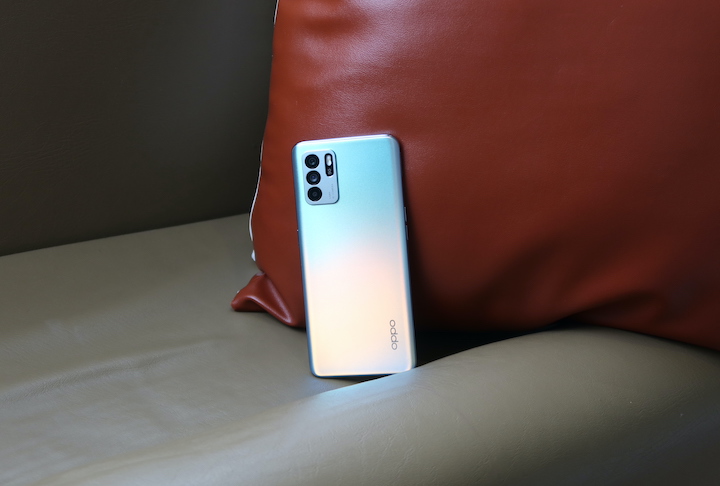Out of all of OPPO’s smartphones, the Reno series is arguably one of the companies most sought-after devices due to its combination of a sleek design, emphasis on the camera features, and an adequately powerful chipset, all at a relatively affordable price point.

This time, we managed to get our hands on the OPPO Reno6 Z 5G, the trimmed-down variant of the classic Reno6. Apart from the usual Reno quirks, it also sports an AMOLED screen, decent battery life, and 30W charging with reverse charging support. So let’s check it out.
Table of Contents
First and foremost, the OPPO Reno6 Z 5G borrows a lot of its design language from the previous Reno5 series and its big brother, the Reno6 5G. So it has the build and curved edges of the Reno5 accompanied by the new glowing colors of the Reno6. What we have here is in the ‘Aurora’ color, which is named after the Northern Lights, and looks really dashing with a metallic texture that somehow looks like it shimmers. The best part is that it doesn’t attract smudges at all.

It’s a pretty polished design, but if you want something more classic, you can opt for the Stellar Black color.

Another aesthetically pleasing factor is in the way it feels. At 179 grams, we can appreciate how effortless it is to hold up for long periods of time. Our unit comes in this Aurora colorway, and thanks to that non-glossy back end, fingerprints and smudges are more or less inexistent on this device, which will be another big plus. It’s also available in Stellar Black as well for that nice and stealthy look.


The Inputs and outputs on this device are more or less what you would expect in any standard smartphone. On the left sits your volume rocker, along with a triple card tray for 2 nano-SIM cards and a microSD card.

Meanwhile, located on the right side is the power/wake button. All the buttons are placed near the center of the frame, so they’re easy to reach even with small hands.


Alone at the top is the secondary microphone. Finally, at the bottom is a USB Type-C port, a single bottom-firing loudspeaker, a primary microphone, and of course, the standard 3.5mm audio port.
When it comes to the display, the OPPO Reno6 Z 5g features a 6.43-inch AMOLED screen with a resolution of 1080 x 2400px, a 20:9 aspect ratio, it comes with a peak brightness of up to a respectable 800 nits, and it also has a Netflix and Amazon HD streaming certification.

It’s almost the same display as the higher Reno6, except it doesn’t have a 90Hz refresh rate option and a 180Hz touch sampling rate.
Generally, the image quality on this phone is a lot more vibrant than other phones with non-AMOLED displays. It not only boasts lively colors, but it also has good contrast and viewing angles. Although it does have a generous screen real-estate, there is still a bit of a chin over here which isn’t really distracting, but it would be much better if this weren’t around. Either way, the viewing experience is still pleasing and definitely passes our standards.
In the display settings, we get the usual options to change color temperature and screen color modes and turn on OPPO’s OSIE vision effect, which uses eye-tracking and artificial intelligence to enhance video playback in some supported apps.

Accompanying the display is a punch hole front camera situated at the top left corner, while the earpiece is tucked away right in the center of the top bezel. As for how it sounds, the OPPO Reno6 Z has a single downward-firing speaker that is actually loud enough to fill up a small room. Moreover, the sound quality is what you would expect in its price range. There’s quite a balanced mids and highs but not so much on bass. Well, feel free to use the headphone jack available if you want better audio quality.
Okay, so the cameras are obviously going to be one of the main highlights of this OPPO Reno6 Z 5G. If you’re wondering, it packs the same lenses as the higher Reno6. That’s a triple camera setup, starting with a 64MP (F/1.7) main shooter, an 8MP (F/2.2) for ultrawide, and a 2MP (F2.4) macro lens.

Shots from the rear camera mostly have great results, especially under ample lighting. Details are very apparent, and shots are vibrant when you need them to be, thanks to the help of AI. It’s even able to patch images that are equivalent to a 108MP photo resolution. At the same time, since this is a camera-centric smartphone, portrait shots look equally as great with commendable subject background separation.
OPPO also included this Bokeh Flare Portrait feature. And what that basically does is automatically transform background lights into a soft filter, which can further illuminate and enhance the subject. On the other hand, Ultrawide is more or less your average, run-of-the-mill lens that’s able to take images at a broader field of view. Although it is considerably much smaller than the main lens, it’s still able to take great image quality during the day. The only time it seems to struggle is whenever we would shoot in very dim places, where most ultrawide cameras fall short anyway.
The same can almost be said for the 2MP macro lens, which works quite well if it’s bright enough. It’s probably going to be the least used camera out of the three, but it’s still somewhat useful if you want to get into the smallest of details.
In addition, it’s able to produce above-average shots when it comes to low light conditions. But depending on the available amount of light, results can vary from a pretty clear image to a fair amount of noise. Colors can tend to be flat too, but it can be a rather great night shooter when used correctly. And speaking of night photography, if you really want some high-quality awesome looking night shots, you can use the tripod mode that’s found within the night mode settings. From the name itself, you’ll need to put the phone on a tripod or any steady surface because it takes about 25 seconds to capture.
When it comes to selfies, the Reno6 Z 5g uses a 32MP front camera that can produce sharp and vibrant photos. It falls more on cooler tones which honestly looks pleasing most of the time. You can notice that there’s a subtle enhancement going on even with the AI mode turned off, but it doesn’t look off for us. On a side note, we like how the beauty mode can provide a low-key touch-up on the subject’s face, but like most beauty modes, it can also go overboard if you want it to.
For videos, the Reno6 Z 5G can record a maximum resolution of 4k at 30FPS, but the ultra steady mode is only available for the 1080p resolution. Apart from gyro-EIS, it also has more video recording features, including Portrait Beautification Mode, Focus Tracking, and Dual-view video mode. This can come in handy for vloggers and maybe even for people who generally want to show what’s happening on both sides of the camera.
Moving on, running the software department is Android 11 skinned with ColorOS 11.1. Now in its 9th iteration, a lot had changed since its first release back in 2013, with lots of added customization allowing you to change the overall theme, icon style and even set your AOD (Always On Display) to different backgrounds. There’s a personalizations category in the settings menu, so you can also switch to pre-installed live wallpapers and customize other interface features such as the fingerprint animation, font, and system colors. In addition, we have gesture navigation enabled by default, which can also be changed to the standard navigation button layout in the settings menu if you’re more accustomed to that style.

A couple of other added features on this UI are floating window, and even Air Gestures, letting you swipe up and down from far away on social or video apps when your hands are occupied. It even answers calls and texts from a distance too. There’s even an Anti-Peeping feature that can automatically detect and hide important information if it detects someone else is looking at your screen. We’re still trying to see how well this works, but we’re glad to have it on board nonetheless. Finally, there’s Adaptive Sleep, which basically prevents the screen from dimming or going to sleep while your eyes remain locked on the screen. A pretty handy feature, to say the least.

On ColorOS, you should also expect to see some bloatware present. Apart from the standard suite of Google apps, we also get a good amount of proprietary OPPO apps and some pre-installed third-party apps as well. Although the latter can easily be uninstalled, it’s nice to see a few of these are what we would normally download anyway.
Locally the Reno6 Z 5G comes with 128GB of internal storage space. And out of that, 128Gigs, we get a usable space of 108GB out of the box, which you can expand via its dedicated microSD card slot.
Internals are handled by a MediaTek Dimensity 800U chipset, a Mali-G57 MC3 GPU, and 8GB of RAM.

When it comes to day-to-day use, like navigating throughout the UI, we didn’t seem to encounter any stutters and issues, while switching to different apps was also a seamless experience. Even without a 90 or 120Hz refresh rate, we’re happy to say that it still feels quite smooth.
As for benchmark tests, the results prove the Reno6 Z can handle most, if not all, the usual tasks that you can think of. In addition, it definitely knows how to hold its own ground with an Antutu v9 score of 370,837 and a 3DMark Slingshot Extreme score of 3,115. But don’t expect to be able to play your favorite heavy game titles at the highest settings, because for one, this is still a mid-range device, and second, that’s probably reserved for their higher models like the Find X series.
If you’re wondering about our other benchmark scores, check them out right here.
• AnTuTu v9 – 370,837
• PC Mark – 7,114 (Work 3.0)
• 3D Mark – 3,115 (SSE OpenGL 3.1), 1,601 (Vulkan)
• Geekbench 5 – 572 (Single-Core), 1,771 (Multi-Core)
• AndroBench – 970.94 MB/s (Seq. Read), 490.23 MB/s (Seq. Write)
For security, the Reno6 Z 5G uses an in-display fingerprint scanner, which works equally well but is placed on the lower part of the display, so you’ll have to adjust your finger to unlock most of the time. The device is, of course, also capable of unlocking via facial recognition. In this case, we found facial recognition working faster and is more practical than placing your thumb on the screen.
Usual connectivity features such as Wifi 5, Bluetooth 5.2, NFC, and GPS can be found on the Reno6 Z 5G. And of course, just like the name suggests, this one has support for 5G connectivity.

Keeping the device powered is a 4310mAh, with support for 30W VOOC Flash Charge 4.0. Admittedly, this charger is not as fast as the 65W SuperVOOC on the Reno6, but hey, it is still fast enough. And while we initially thought it wouldn’t last the whole day, we’re glad that it was able to prove us wrong.
In our standard video loop test, which entails a 1080p video playing at 50% brightness, 50% volume, with Airplane Mode and headphones on, it was able to last 19 hours and 33 minutes. Meanwhile, charging takes 1 whole hour to reach a full charge. With that being said, we’re not breaking any records here, but it’s safe to say this device will be able to provide you with a full day’s work, just as long as you’re not continuously running demanding tasks.
As for how much it costs, this OPPO Reno6 Z 5G is officially priced at PHP 19,999USD 341INR 28,891EUR 325CNY 2,482, which is relatively much cheaper than the more expensive Reno 6 5G priced at PHP 26,999USD 460INR 39,003EUR 438CNY 3,351. We appreciate how it’s still a lot similar to the superior Reno6, that even when it comes to performance and cameras, they’re at par.
Although we do adore the boxy and premium design of the higher Reno6, we must say that OPPO has done a pretty good job with the Reno6 Z 5g. It’s not a bad option at all despite the trimmings to achieve its more affordable price.

On its own, you’re getting a reliable set of cameras, commendable performance, 5G connectivity, and a refreshing UI that I’m sure is going to be helpful to many. On a side note, if you’re really eyeing an OPPO smartphone, you may want to consider the Reno5 series released this year since it also floats around the same price range.
With inputs from Justine Basco
OPPO Reno6 Z 5G specs:
6.4-inch FHD+ (2400 x 1080) AMOLED display, 411PPI
MediaTek Dimensity 800U 5G SoC
ARM Mali-G57 MC3 GPU
8GB RAM
128GB storage
microSD card slot
Triple rear cameras:
• 64MP F1.7 (main)
• 8MP F2.2 (wide)
• 2MP F2.4 (macro)
32MP F2.4 front camera
5G, 4G LTE
Dual-SIM (nano)
WiFi 6
Bluetooth 5.2
GPS, GLONASS, GALILEO, QZSS, Beidou
USB Type-C
Fingerprint scanner (in-display)
Face Unlock
ColorOS 11.3 (Android 11)
4,310mAh battery w/ 30W VOOC Flash Charge 4.0
160.20 x 73.38 x 7.97mm
173g
Stellar Black, Aurora

YugaTech.com is the largest and longest-running technology site in the Philippines. Originally established in October 2002, the site was transformed into a full-fledged technology platform in 2005.
How to transfer, withdraw money from PayPal to GCash
Prices of Starlink satellite in the Philippines
Install Google GBox to Huawei smartphones
Pag-IBIG MP2 online application
How to check PhilHealth contributions online
How to find your SIM card serial number
Globe, PLDT, Converge, Sky: Unli fiber internet plans compared
10 biggest games in the Google Play Store
LTO periodic medical exam for 10-year licenses
Netflix codes to unlock hidden TV shows, movies
Apple, Asus, Cherry Mobile, Huawei, LG, Nokia, Oppo, Samsung, Sony, Vivo, Xiaomi, Lenovo, Infinix Mobile, Pocophone, Honor, iPhone, OnePlus, Tecno, Realme, HTC, Gionee, Kata, IQ00, Redmi, Razer, CloudFone, Motorola, Panasonic, TCL, Wiko
Best Android smartphones between PHP 20,000 - 25,000
Smartphones under PHP 10,000 in the Philippines
Smartphones under PHP 12K Philippines
Best smartphones for kids under PHP 7,000
Smartphones under PHP 15,000 in the Philippines
Best Android smartphones between PHP 15,000 - 20,000
Smartphones under PHP 20,000 in the Philippines
Most affordable 5G phones in the Philippines under PHP 20K
5G smartphones in the Philippines under PHP 16K
Smartphone pricelist Philippines 2024
Smartphone pricelist Philippines 2023
Smartphone pricelist Philippines 2022
Smartphone pricelist Philippines 2021
Smartphone pricelist Philippines 2020